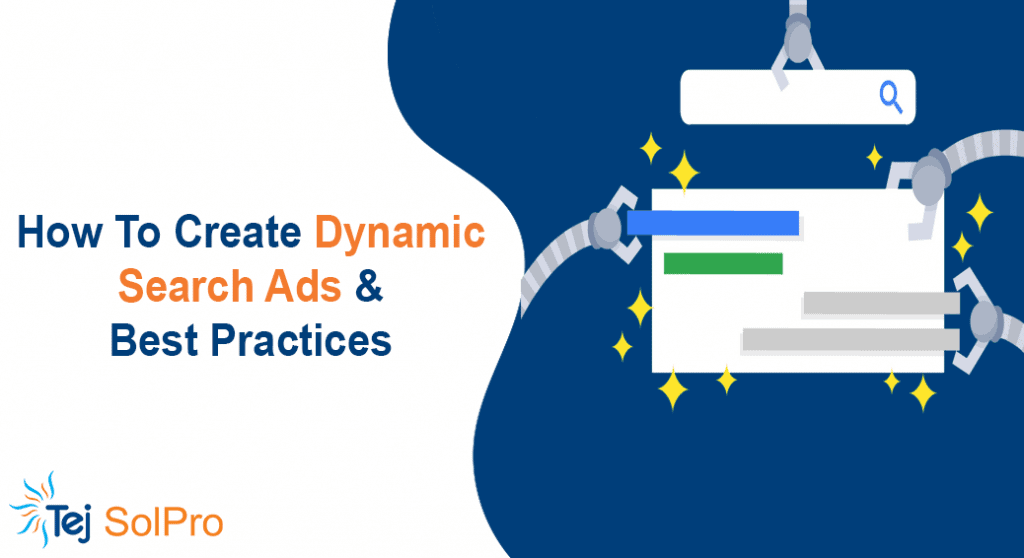Who doesn’t like an influx of visitors on his or her website? Several methods are used to drive maximum traffic to your websites such as advertisements and online campaigns. One of the effective ways is Google Dynamic Search Ads (DSA’s). DSA’s are displayed for queries or search terms that are relevant to the terms used on your website. But it is of utmost importance to be aware of how DSA’s exactly work or it may backfire.
A lot goes behind Dynamic Search Ads! In this exhaustive article, we have covered a range of topics for your benefit that includes how to create Dynamic Search Ads, Dynamic Search ads best practices and the advantages and disadvantages of Dynamic Search Ads.
What Are Dynamic Search Ads?
Dynamic Search Ads are ads that depend on the content of your website. Here, Google does your job. Depending on the search terms that are related to the content on your website, Google crawls your website.
DSA’s are considered to be the simplest way to find customers who are searching for what you offer on Google. Google creates headlines for you. This is an ever-changing process wherein depending on the search term, the system dynamically creates an ad with a headline based on the term and the content on your landing page.
Make sure to add a creative description to your website. Dynamic Search Ads are not just another ad. DSA’s will land the user directly on your website. The biggest advantage of DSA is it fills the gap in inventory between keywords and content on your site.
How Do Dynamic Search Ads Work?
Dynamic Search Ads works the following way:
Let’s say someone searches on Google with words and terms that are closely related to the content, titles and phrases used on your website. These matching phrases and titles will be used by Google Ads in order to choose a landing page from your website and create a headline on similar lines for your ad.
For example, you own an international hotel chain. People searching on Google for ‘Luxury hotel Mumbai’ will see your ad with the headline ‘Luxury Hotel – Mumbai’. If someone clicks on the ad which lands on the page of your website which is dedicated to your Mumbai luxury locations.
Dynamic Search Ads are really helpful in driving potential customers to your website.
How To Create Dynamic Search Ads?
The step-by-step process on how to create dynamic search ads is as follows:
Step 1:
First of all, create a new campaign (For search network only)
Step 2:
Go to ‘Type’ and select Dynamic Search Ads and then name your campaign.
Step 3:
After adding the basic details, mention your device, network, language settings and most importantly geographic location.
Step 4:
Another crucial step is to select bidding and budget options. If it is your first DSA campaign, it is advisable to go for automated bidding. Try investing in a nominal budget and then let Google do what it can do best from the budget.
Step 5:
Before moving ahead, form a new dynamic search ads extension for the original domain of your website.
Step 6:
Give a name to your first ad group and then form your first Dynamic Search Ad. You should ideally go for a generic ad for your first DSA adgroup. Since the headline will be executed by Google, it will be in sync with a lot of search queries.
Advantages and Disadvantages of Dynamic Ads
Advantages
High-Quality Traffic
Dynamic search ads are best for those businesses that actively require maintaining constant communication with their clients. The dynamic ads help kickstart fresh campaigns and add new offers. Dynamic search ads are also the reason behind your enhanced website traffic which may also convert your leads to sales. Dynamic search ads are a pocket-friendly way to drive high-quality traffic to your relevant landing pages.
Quick-paced and Flexible
Since Google will do the majority of the job, you can focus on more important things that require your attention. Interestingly, the template can be repeated for a longer time, only new content needs to be added at regular intervals. Don’t be laid back and keep an eye on your campaign performance to see if you’re receiving justice against your budget.
Close the Gap in Keyword Coverage
One of the most important advantages of Dynamic Search Ads is it bridges the gap between keyword coverage and product inventory. DSA’s help you crawl your website or a page feed that has listed all products. Furthermore, DSA’s may also display keywords that are typically flagged in Google Ads.
Dynamic Headlines
Interestingly, the headline on a DSA is dynamically formed from Google. The information that leads to the formation of a headline is obtained from the website or feed. You still need to write a description line for the ads.
Disadvantages
Lack of full control
You’ll be clueless as to which queries are being matched, thus it is of utmost importance to form your structure appropriately and account for proper negatives at places possible. Make sure to monitor the search term reports, initially quite closely.
Headlines don’t match the ads
There is no doubt that dynamic headlines are really effective but it may not work well with all the advertisers. In Dynamic Search Ads, the headlines are formed completely based on the website content or product content available on the feed. It is very less likely that a headline will not match. If you wish to have full control over which headlines should go, then Dynamic Search Ads may not deem fit for you.
Investment VS Goals
Your campaigns need to be regular and updation of information must happen regularly. If that doesn’t seem possible, then Dynamic Search Ads are not for your business. Dynamic Ads solely depends on the budget invested, scale and time span of your campaign, time restrictions, data and so on.
Best Practices for Dynamic Search Ads
Keep in mind the following Dynamic Search Ads best practices for better results:
Strong Quality Content
Since Google decides on a lot of things when it comes to Dynamic Search Ads, you need to ensure that your content covers all the aspects. The reason being the keywords, ad copy and landing pages are selected in real-time by Google. Thus, it is really important to serve all the things that are on your plate to Google while maintaining quality.
Detailed Description of Product/Service
One of them being product or service descriptions. You should give enough information about the product for them to take action. Specific and in-depth details do matter, for Google to show your Dynamic Search Ads. Half information or missing information will lessen the possibility.
Avoid Using Jargons
The simpler, the better. You may be able to attract a lot of people to your website or content with heavy jargons or technical terms, but will not be helpful when it comes to Dynamic Search Ads. Such words aren’t used to determine a landing page. It might be valuable to a few of your customers but Google shall go for simpler words and terms used for DSA’s.
Use More Text Than Images
Images can do wonders for your website, however, for Dynamic Search Ads, you should go more text than images. It isn’t possible for Google to form DSA’s based on images. The tools should be able to gather information based on your text. Only images for DSA’s is a big no-no.
Latest and Accurate Information
After ensuring you have enough content for the Dynamic Search Ads tool to perform, another important factor is to tick-off is to make sure the content on your site is up to date. The query needs to match the content of your website. Have you offered discounts, changed the price, or removed or added a product? All these things should reflect on your website.
Include Negative Keywords
Do not forget to add negative keywords in your ad groups. There is a possibility that your website will be visited by irrelevant people, and when their purpose isn’t served they will leave the website thus increasing the bounce rate. It will negatively affect your website ranking. Thus, it is important to add negative keywords to your list so that you can avoid such irrelevant clicks.
Behaviour-based Targeting
It is highly recommended to be relevant in ads. For behavior-based targeting, the factors that you need to keep in mind include visitor browsing habits, search terms, sites visited, and purchases. You need to cover the minutest and relevant search queries targeting ad groups based on the user behavior that will help increase your conversion rates.
Adding CTA’s
Calls to action is a must-have. If the visitors are convinced, the availability of a call to action will compel them to take action by clicking on the website link or service page. Through CTA’s, you’re directing the visitors to their needs which motivates them to take action. CTA gives them clarity on what they are supposed to do next. CTA’s are just like billboards, conveying the visitors what they offer, ways to reach them and giving them the directive to do so.
Bid Adjustments
Since Display Ad Campaigns operate on a Cost-per-Click basis, the advertisers ought to pay a negligible amount whenever a user clicks on the ad. It is advisable to turn bids to the auto-target level. There will be some extra work, but you’ll have to set bids for every auto-target and then you can show the outcome based on your advertisement ranking. Bid adjustments also give you more control over when and where your ad is displayed.
Conclusion
Dynamic Search Ads is an extremely useful tool to target campaigns and generate extra leads to your website. However, it requires regular follow-ups so that the investment is worth the time and money spent. Before you delve into Dynamic Search Ads, make sure to thoroughly go through the pros and cons, have a complete understanding of the DSA’s and how to create Dynamic Search Ads.
Let us know your opinion or feedback in the comments below.






